Publications
publications by categories in reversed chronological order.
2025
- Manifestations of flow topology in a quantum driven-dissipative systemKilian Seibold, Greta Villa, Javier Pino, and 1 more author2025
In driven-dissipative bosonic systems, the interplay between coherent driving, inter-particle interactions and dissipation leads to a rich variety of non-equilibrium stationary states (NESS). In the semiclassical limit, the flow topology of phase-space dynamics governs the stability and structure of these dynamical phases. Consequently, topological transitions occur when the number of NESS, their chirality, or their connectivity changes, reflecting global reorganization in the system’s dynamical phase-space landscape. Here, we study the corresponding topological signatures in a driven-dissipative quantum Kerr oscillator. Employing a Lindblad master equation and quantum trajectory methods, we reveal that quantum dynamics retain key topological features of the underlying classical flows, with clear signatures accessible via quantum state tomography and linear response. In this manner, we predict new phases that are not signaled by Liouvillian gap closing, thereby generalizing the conventional criteria for diagnosing phase transitions. Our findings position phase-space flow topology as a powerful tool to identify and control robust quantum phases, enabling advances in error correction and sensing.
-
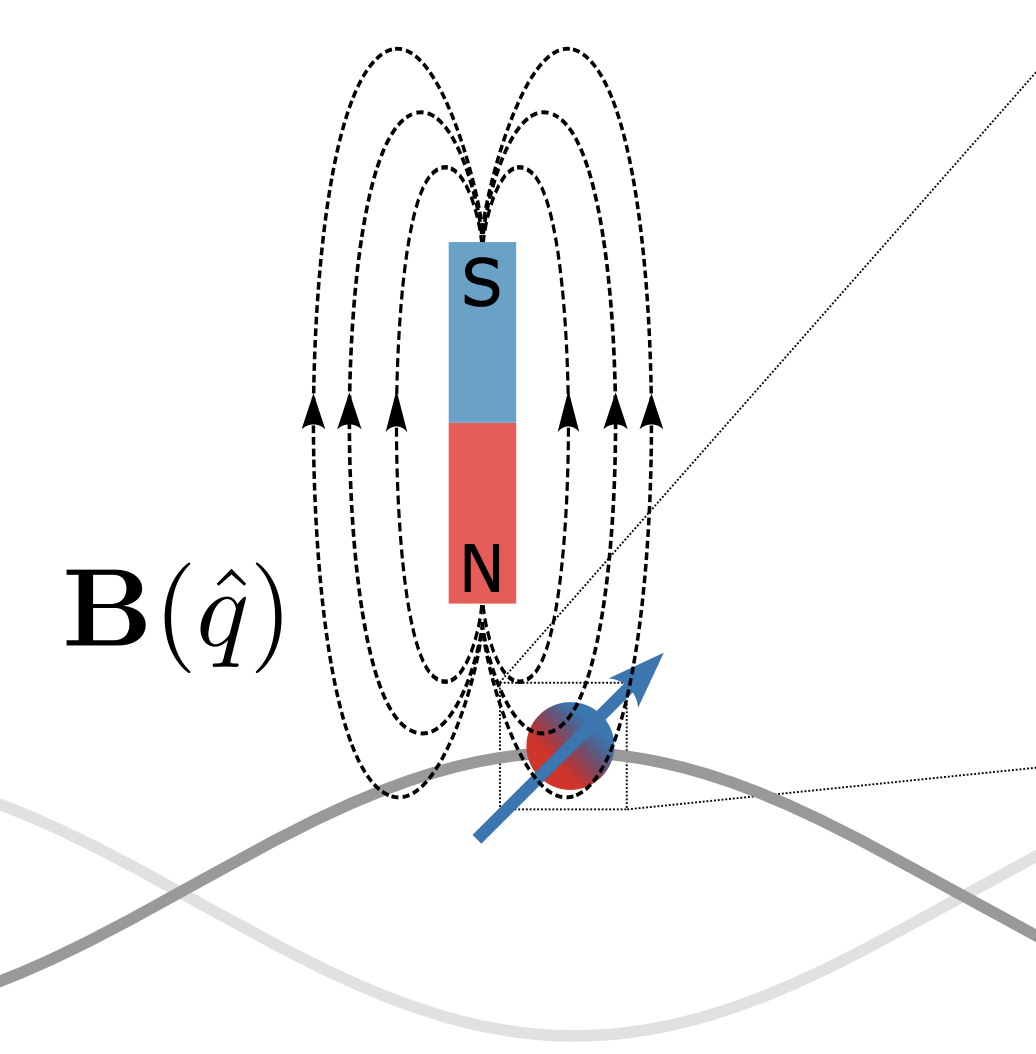 Near-resonant nuclear spin detection with megahertz mechanical resonatorsDiego A. Visani, Letizia Catalini, Christian L. Degen, and 2 more authors2025
Near-resonant nuclear spin detection with megahertz mechanical resonatorsDiego A. Visani, Letizia Catalini, Christian L. Degen, and 2 more authors2025Mechanical resonators operating in the megahertz range have become a versatile platform for fundamental and applied quantum research. Their exceptional properties, such as low mass and high quality factor, make them also appealing for force sensing experiments. In this work, we propose a method for detecting, and ultimately controlling, nuclear spins by coupling them to megahertz resonators via a magnetic field gradient. Dynamical backaction between the sensor and an ensemble of N nuclear spins produces a shift in the sensor’s resonance frequency. The mean frequency shift due to the Boltzmann polarization is challenging to measure in nanoscale sample volumes. Here, we show that the fluctuating polarization of the spin ensemble results in a measurable increase of the resonator’s frequency variance. On the basis of analytical as well as numerical results, we predict that the variance measurement will allow single nuclear spin detection with existing resonator devices.
@article{visani2025nearresonantnuclearspindetection, title = {Near-resonant nuclear spin detection with megahertz mechanical resonators}, author = {Visani, Diego A. and Catalini, Letizia and Degen, Christian L. and Eichler, Alexander and del Pino, Javier}, year = {2025}, eprint = {2508.14754}, archiveprefix = {arXiv}, primaryclass = {cond-mat.mes-hall}, url = {https://arxiv.org/abs/2508.14754} } -
 Topological classification of driven-dissipative nonlinear systemsGreta Villa, Alexander Eichler, and Oded ZilberbergScience Advances, Aug 2025
Topological classification of driven-dissipative nonlinear systemsGreta Villa, Alexander Eichler, and Oded ZilberbergScience Advances, Aug 2025In topology, averaging over local geometrical details reveals robust global features. These are crucial in physics for understanding quantized bulk transport and exotic boundary effects of linear wave propagation in (meta-)materials. Beyond linear Hamiltonian systems, topological physics strives to characterize open (non-Hermitian) and interacting systems. Here, we establish a framework for the topological classification of driven-dissipative nonlinear systems by defining a graph index for their Floquet semiclassical equations of motion. Our index builds upon the topology of vector flows and encodes the particle-hole nature of excitations around all out-of-equilibrium stationary states. Thus, we uncover the topology of nonlinear resonator’s dynamics under external and parametric forcing. Our framework sheds light on the topology of driven-dissipative phases, including under- to overdamped responses and symmetry-broken phases linked to population inversion. We therefore expose the pervasive link between topology and nonlinear dynamics, with broad implications for interacting topological insulators, topological solitons, neuromorphic networks, and bosonic codes.
@article{villa_topological_2025, title = {Topological classification of driven-dissipative nonlinear systems}, language = {en}, journal = {Science Advances}, author = {Villa, Greta and Eichler, Alexander and Zilberberg, Oded}, year = {2025}, month = aug, file = {PDF:/Users/jdelpino_ethz/Zotero/storage/7P68GSUU/Villa et al. - 2025 - Topological classification of driven-dissipative nonlinear systems.pdf:application/pdf} } -
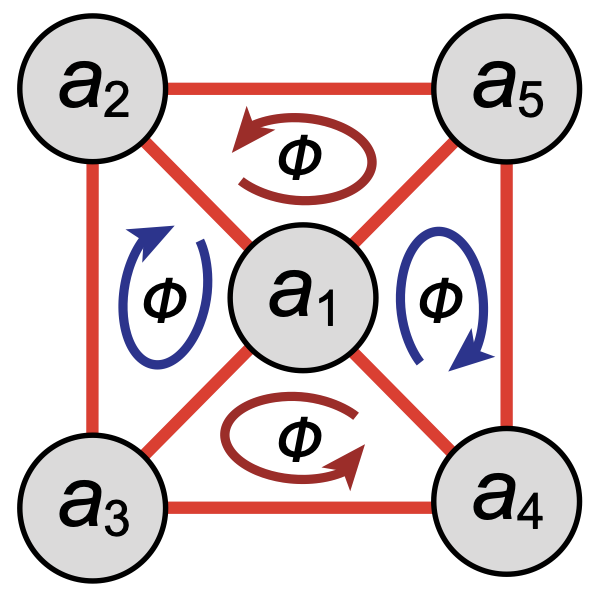 Programmable synthetic magnetism and chiral edge states in nano-optomechanical quantum Hall networksJesse J. Slim, Javier Del Pino, and Ewold VerhagenNature Communications, Aug 2025
Programmable synthetic magnetism and chiral edge states in nano-optomechanical quantum Hall networksJesse J. Slim, Javier Del Pino, and Ewold VerhagenNature Communications, Aug 2025Artificial magnetic fields break time-reversal symmetry in engineered materials–also known as metamaterials, enabling robust, topological transport of neutral excitations, much like electronic conduction edge channels in the integer quantum Hall effect. We experimentally demonstrate the emergence of quantum-Hall-like chiral edge states in optomechanical resonator networks. Synthetic magnetic fields for phononic excitations are induced through laser drives, while cavity optomechanical control allows full reconfigurability of the effective metamaterial response of the networks, including programming of magnetic fluxes in multiple resonator plaquettes. By tuning the interplay between network connectivity and magnetic fields, we demonstrate both flux-sensitive and flux-insensitive localized mechanical states. Scaling up the system creates spectral features that are precursors to Hofstadter butterfly spectra. Site-resolved spectroscopy reveals edge-bulk separation, with stationary phononic distributions signaling chiral edge modes. We directly probe those edge modes in transport measurements to demonstrate a unidirectional acoustic channel. This work unlocks new ways of controlling topological phononic phases at the nanoscale with applications in noise management and information processing.
@article{slim_programmable_2025, title = {Programmable synthetic magnetism and chiral edge states in nano-optomechanical quantum {Hall} networks}, volume = {16}, issn = {2041-1723}, url = {https://www.nature.com/articles/s41467-025-62541-z}, doi = {10.1038/s41467-025-62541-z}, language = {en}, number = {1}, urldate = {2025-08-19}, journal = {Nature Communications}, author = {Slim, Jesse J. and Del Pino, Javier and Verhagen, Ewold}, month = aug, year = {2025}, pages = {7471}, file = {Slim et al. - 2025 - Programmable synthetic magnetism and chiral edge states in nano-optomechanical quantum Hall networks.pdf:/Users/jdelpino_ethz/Library/CloudStorage/Dropbox/javier/work/bibliography/papers/Slim et al. - 2025 - Programmable synthetic magnetism and chiral edge states in nano-optomechanical quantum Hall networks.pdf:application/pdf} } - Phys. Rev. Res.Sideband attraction via internal resonance in a multimode membrane as a mechanism for frequency combsMengqi Fu, Orjan Ameye, Fan Yang, and 4 more authorsPhysical Review Research, Aug 2025
We explore self-induced parametric coupling between a driven (low frequency) and an undriven (high frequency) mode, also called internal resonances, in a membrane micromechanical system. Specifically, we focus on the formation of a limit cycle (LC) manifesting as a phononic frequency comb. As the LC formation involves a Hopf bifurcation, we developed a dedicated pump-noisy-probe technique to investigate which mechanical sidebands merge at the bifurcation. We reveal that the sideband of the driven lower mode is up-converted via a cross-Duffing nonlinearity to hybridize with the undriven high mode. When the up-conversion is initially red detuned relative to the high mode, significant squeezing and bimodality in the high mode occurs. Crucially, only when the up-converted sideband is initially blue detuned relative to the high mode, the sideband is attracted to the high mode and merges to form the Hopf bifurcation. This process delineates the microscopic origin of frequency comb formation. Our study reveals a key instability mechanism in driven nonlinear systems with implications for advanced sensing technologies and phononic metamaterials.
@article{fu2025fluctuationinstabilitiesinternalresonance, title = {Sideband attraction via internal resonance in a multimode membrane as a mechanism for frequency combs}, volume = {7}, issn = {2643-1564}, url = {https://link.aps.org/doi/10.1103/3mtc-j9r9}, doi = {10.1103/3mtc-j9r9}, language = {en}, number = {3}, urldate = {2025-08-19}, journal = {Physical Review Research}, author = {Fu, Mengqi and Ameye, Orjan and Yang, Fan and Košata, Jan and Del Pino, Javier and Zilberberg, Oded and Scheer, Elke}, month = aug, year = {2025}, pages = {033127}, file = {PDF:/Users/jdelpino_ethz/Zotero/storage/APSP3XZ8/Fu et al. - 2025 - Sideband attraction via internal resonance in a multimode membrane as a mechanism for frequency comb.pdf:application/pdf} } -
 Slow and fast topological dynamical phase transitions in a Duffing resonator driven by two detuned tonesLetizia Catalini, Javier Pino, Soumya S. Kumar, and 4 more authorsPhys. Rev. Res., Jul 2025
Slow and fast topological dynamical phase transitions in a Duffing resonator driven by two detuned tonesLetizia Catalini, Javier Pino, Soumya S. Kumar, and 4 more authorsPhys. Rev. Res., Jul 2025Nonlinear dynamics are studied in diverse fields as climate models, avalanches, nanomechanical sensors, optical frequency converters, and electrical quantum amplifiers. A widely studied nonlinear model is the so-called Duffing (or Kerr) resonator, which features a quartic potential term. Two hallmark properties of this model are (i) a shift of a system’s resonance frequency as a function of the driving strength, and (ii) monostable or bistable responses, depending on the drive strength and detuning from resonance. Together, these two properties can lead to dynamical phase transitions when several drives are applied simultaneously. Here, we report an experimental and theoretical study of a driven-dissipative nonlinear system with two detuned drives. We observe distinct response regimes characterized by the system’s ability to follow the system’s time-dependent vector-flow topology. Our work provides an example for understanding dynamical phase transitions in out-of-equilibrium nonlinear systems.
@article{catalini2025slowfasttopologicaldynamical, title = {Slow and fast topological dynamical phase transitions in a Duffing resonator driven by two detuned tones}, author = {Catalini, Letizia and del Pino, Javier and Kumar, Soumya S. and Dumont, Vincent and Margiani, Gabriel and Zilberberg, Oded and Eichler, Alexander}, journal = {Phys. Rev. Res.}, volume = {7}, issue = {3}, pages = {033058}, numpages = {6}, year = {2025}, month = jul, publisher = {American Physical Society}, doi = {10.1103/y9gq-yjxy}, url = {https://link.aps.org/doi/10.1103/y9gq-yjxy}, }
2024
-
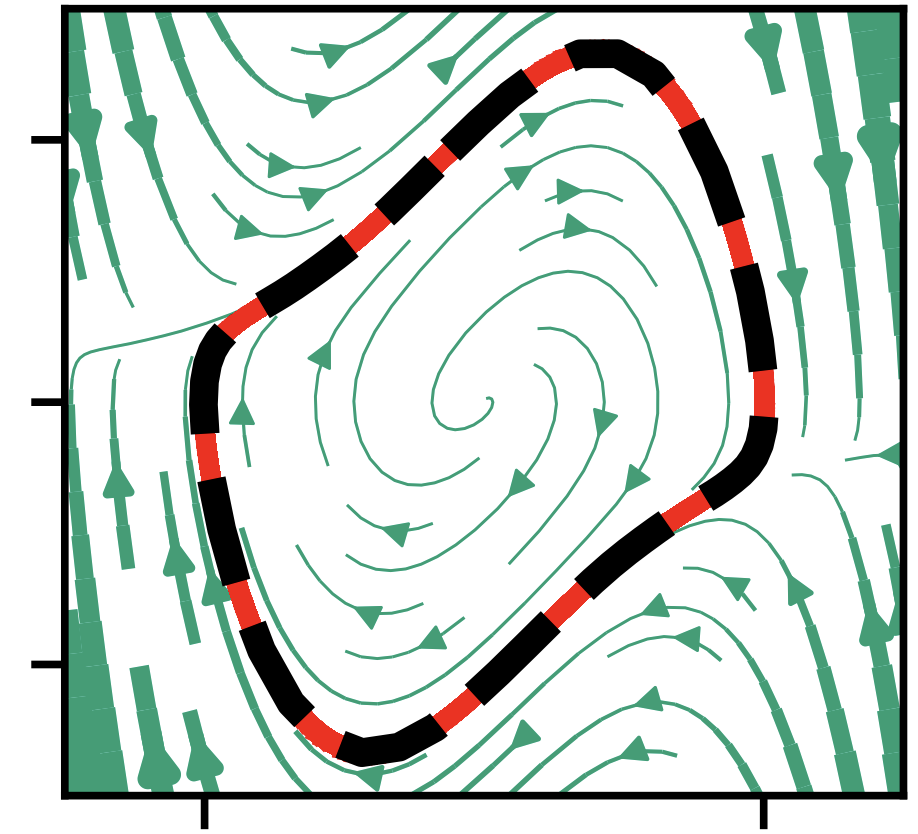 Limit cycles as stationary states of an extended harmonic balance ansatzJavier Pino, Jan Košata, and Oded ZilberbergPhys. Rev. Res., Aug 2024
Limit cycles as stationary states of an extended harmonic balance ansatzJavier Pino, Jan Košata, and Oded ZilberbergPhys. Rev. Res., Aug 2024A limit cycle is a self-sustained, periodic, isolated motion appearing in autonomous differential equations. As the period of a limit cycle is a priori unknown, finding it as a stationary state of a rotating ansatz is challenging. Correspondingly, its study commonly relies on numerical methodologies (e.g., brute-force time evolution, and variational shooting methods) or circumstantial evidence such as instabilities of fixed points. Alas, such approaches are (i) unable to find all solutions, as they rely on specific initial conditions, and (ii) do not provide analytical intuition about the physical origin of the limit cycles. Here, we (I) develop a multifrequency rotating ansatz with which we (II) find all limit cycles as stationary-state solutions via a semianalytical homotopy continuation. We demonstrate our approach and its performance on the Van der Pol oscillator. Moving beyond this simple example, we show that our method captures all coexisting fixed-point attractors and limit cycles in a modified nonlinear Van der Pol oscillator. Our results facilitate the systematic mapping of out-of-equilibrium phase diagrams, with implications across multiple fields of the natural sciences.
@article{PhysRevResearch.6.033180, title = {Limit cycles as stationary states of an extended harmonic balance ansatz}, author = {del Pino, Javier and Košata, Jan and Zilberberg, Oded}, journal = {Phys. Rev. Res.}, volume = {6}, issue = {3}, pages = {033180}, numpages = {12}, year = {2024}, month = aug, publisher = {American Physical Society}, doi = {10.1103/PhysRevResearch.6.033180}, url = {https://link.aps.org/doi/10.1103/PhysRevResearch.6.033180}, } -
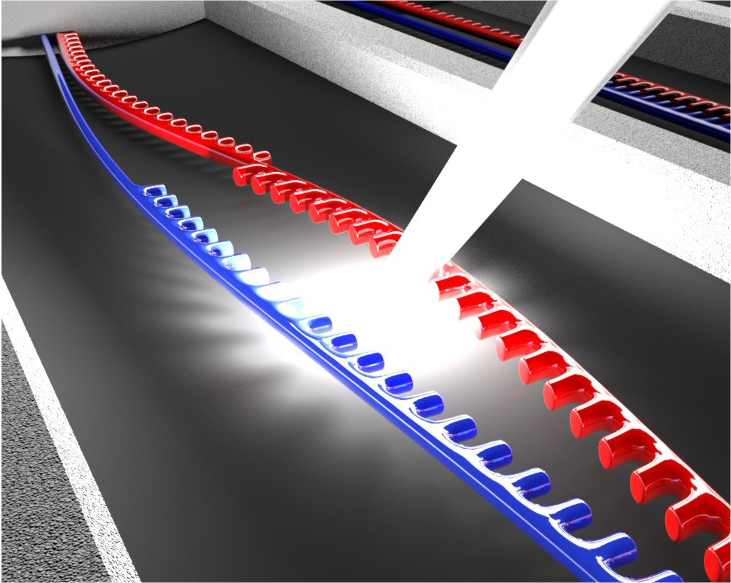 Optomechanical realization of the bosonic Kitaev chainJesse J. Slim, Clara C. Wanjura, Matteo Brunelli, and 3 more authorsNature, Mar 2024
Optomechanical realization of the bosonic Kitaev chainJesse J. Slim, Clara C. Wanjura, Matteo Brunelli, and 3 more authorsNature, Mar 2024The fermionic Kitaev chain is a canonical model featuring topological Majorana zero modes1. We report the experimental realization of its bosonic analogue2 in a nano-optomechanical network, in which the parametric interactions induce beam-splitter coupling and two-mode squeezing among the nanomechanical modes, analogous to hopping and p-wave pairing in the fermionic case, respectively. This specific structure gives rise to a set of extraordinary phenomena in the bosonic dynamics and transport. We observe quadrature-dependent chiral amplification, exponential scaling of the gain with system size and strong sensitivity to boundary conditions. All these are linked to the unique non-Hermitian topological nature of the bosonic Kitaev chain. We probe the topological phase transition and uncover a rich dynamical phase diagram by controlling interaction phases and amplitudes. Finally, we present an experimental demonstration of an exponentially enhanced response to a small perturbation3,4. These results represent the demonstration of a new synthetic phase of matter whose bosonic dynamics do not have fermionic parallels, and we have established a powerful system for studying non-Hermitian topology and its applications for signal manipulation and sensing.
@article{slim2024optomechanical, author = {Slim, Jesse J. and Wanjura, Clara C. and Brunelli, Matteo and del Pino, Javier and Nunnenkamp, Andreas and Verhagen, Ewold}, date = {2024/03/01}, date-added = {2024-03-28 15:32:42 +0700}, date-modified = {2024-03-28 15:32:42 +0700}, doi = {10.1038/s41586-024-07174-w}, id = {Slim2024}, isbn = {1476-4687}, journal = {Nature}, number = {8005}, pages = {767--771}, title = {Optomechanical realization of the bosonic Kitaev chain}, url = {https://doi.org/10.1038/s41586-024-07174-w}, volume = {627}, year = {2024}, bdsk-url-1 = {https://doi.org/10.1038/s41586-024-07174-w}, month = mar } - JMPAKhovanskii bases for semimixed systems of polynomial equations–Approximating stationary nonlinear Newtonian dynamicsViktoriia Borovik, Paul Breiding, Javier Pino, and 2 more authorsJournal de Mathématiques Pures et Appliquées, Feb 2024
@article{borovik2024khovanskii, title = {Khovanskii bases for semimixed systems of polynomial equations--Approximating stationary nonlinear Newtonian dynamics}, author = {Borovik, Viktoriia and Breiding, Paul and del Pino, Javier and Micha{\l}ek, Mateusz and Zilberberg, Oded}, journal = {Journal de Math{\'e}matiques Pures et Appliqu{\'e}es}, volume = {182}, pages = {195--222}, year = {2024}, publisher = {Elsevier}, month = feb } -
 Biased Ising Model Using Two Coupled Kerr Parametric Oscillators with External ForcePablo Álvarez, Davide Pittilini, Filippo Miserocchi, and 6 more authorsPhys. Rev. Lett., May 2024
Biased Ising Model Using Two Coupled Kerr Parametric Oscillators with External ForcePablo Álvarez, Davide Pittilini, Filippo Miserocchi, and 6 more authorsPhys. Rev. Lett., May 2024Networks of coupled Kerr parametric oscillators (KPOs) are a leading physical platform for analog solving of complex optimization problems. These systems are colloquially known as “Ising machines.” We experimentally and theoretically study such a network under the influence of an external force. The force breaks the collective phase-parity symmetry of the system and competes with the intrinsic coupling in ordering the network configuration, similar to how a magnetic field biases an interacting spin ensemble. Specifically, we demonstrate how the force can be used to control the system, and highlight the crucial role of the phase and symmetry of the force. Our Letter thereby provides a method to create Ising machines with arbitrary bias, extending even to exotic cases that are impossible to engineer in real spin systems.
@article{alvarez2023biased, title = {Biased Ising Model Using Two Coupled Kerr Parametric Oscillators with External Force}, author = {\'Alvarez, Pablo and Pittilini, Davide and Miserocchi, Filippo and Raamamurthy, Sathyanarayanan and Margiani, Gabriel and Ameye, Orjan and del Pino, Javier and Zilberberg, Oded and Eichler, Alexander}, journal = {Phys. Rev. Lett.}, volume = {132}, issue = {20}, pages = {207401}, numpages = {7}, year = {2024}, month = may, publisher = {American Physical Society}, doi = {10.1103/PhysRevLett.132.207401}, url = {https://link.aps.org/doi/10.1103/PhysRevLett.132.207401}, }
2023
-
 Quadrature nonreciprocity in bosonic networks without breaking time-reversal symmetryClara C Wanjura, Jesse J Slim, Javier Pino, and 3 more authorsNature Physics, Jul 2023
Quadrature nonreciprocity in bosonic networks without breaking time-reversal symmetryClara C Wanjura, Jesse J Slim, Javier Pino, and 3 more authorsNature Physics, Jul 2023Nonreciprocity means that the transmission of a signal depends on its direction of propagation. Despite vastly different platforms and underlying working principles, the realisations of nonreciprocal transport in linear, time-independent systems rely on Aharonov-Bohm interference among several pathways and require breaking time-reversal symmetry. Here we extend the notion of nonreciprocity to unidirectional bosonic transport in systems with a time-reversal symmetric Hamiltonian by exploiting interference between beamsplitter (excitation preserving) and two-mode-squeezing (excitation non-preserving) interactions. In contrast to standard nonreciprocity, this unidirectional transport manifests when the mode quadratures are resolved with respect to an external reference phase. Hence we dub this phenomenon quadrature nonreciprocity. First, we experimentally demonstrate it in the minimal system of two coupled nanomechanical modes orchestrated by optomechanical interactions. Next, we develop a theoretical framework to characterise the class of networks exhibiting quadrature nonreciprocity based on features of their particle-hole graphs. In addition to unidirectionality, these networks can exhibit an even-odd pairing between collective quadratures, which we confirm experimentally in a four-mode system, and an exponential end-to-end gain in the case of arrays of cavities. Our work opens up new avenues for signal routing and quantum-limited amplification in bosonic systems.
@article{wanjura2023quadrature, title = {Quadrature nonreciprocity in bosonic networks without breaking time-reversal symmetry}, author = {Wanjura, Clara C and Slim, Jesse J and del Pino, Javier and Brunelli, Matteo and Verhagen, Ewold and Nunnenkamp, Andreas}, journal = {Nature Physics}, volume = {19}, number = {10}, pages = {1429--1436}, year = {2023}, publisher = {Nature Publishing Group UK London}, month = jul } -
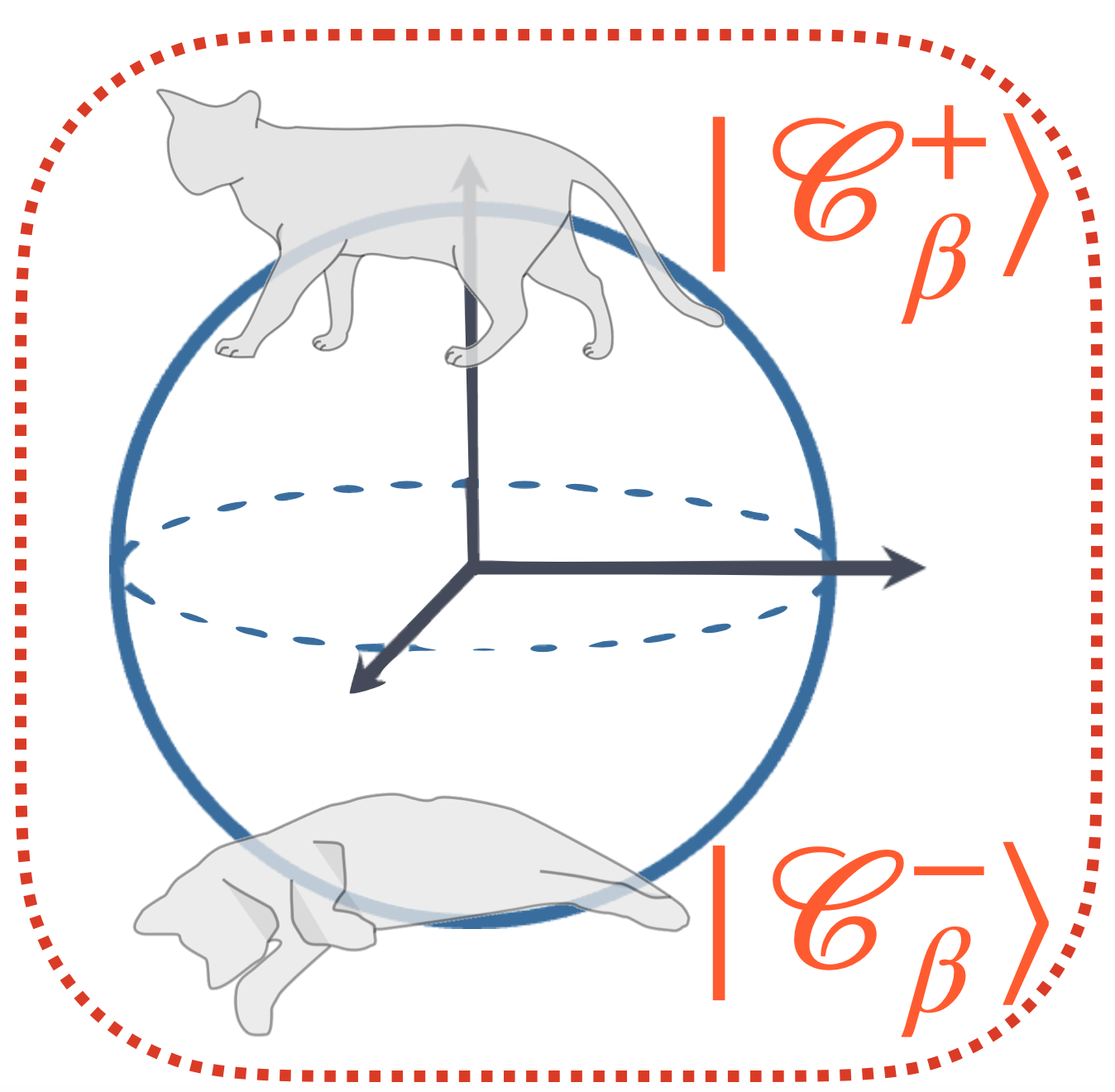 Dynamical Gauge Fields with Bosonic CodesJavier Pino, and Oded ZilberbergPhys. Rev. Lett., Apr 2023
Dynamical Gauge Fields with Bosonic CodesJavier Pino, and Oded ZilberbergPhys. Rev. Lett., Apr 2023The quantum simulation of dynamical gauge field theories offers the opportunity to study complex high-energy physics with controllable low-energy devices. For quantum computation, bosonic codes promise robust error correction that exploits multiparticle redundancy in bosons. Here, we demonstrate how bosonic codes can be used to simulate dynamical gauge fields. We encode both matter and dynamical gauge fields in a network of resonators that are coupled via three-wave mixing. The mapping to a Z2 dynamical lattice gauge theory is established when the gauge resonators operate as Schrödinger cat states. We explore the optimal conditions under which the system preserves the required gauge symmetries. Our findings promote realizing high-energy models using bosonic codes.
@article{PhysRevLett.130.171901, title = {Dynamical Gauge Fields with Bosonic Codes}, author = {del Pino, Javier and Zilberberg, Oded}, year = {2023}, month = apr, journal = {Phys. Rev. Lett.}, publisher = {American Physical Society}, volume = {130}, pages = {171901}, doi = {10.1103/PhysRevLett.130.171901}, url = {https://link.aps.org/doi/10.1103/PhysRevLett.130.171901}, issue = {17}, numpages = {8}, } -
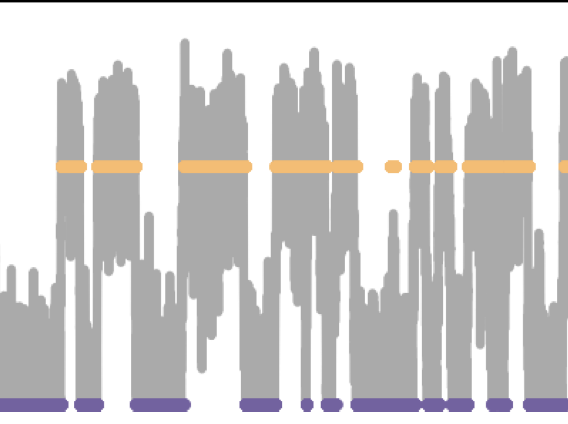 Deterministic and stochastic sampling of two coupled Kerr parametric oscillatorsGabriel Margiani, Javier Pino, Toni L. Heugel, and 6 more authorsPhys. Rev. Res., Feb 2023
Deterministic and stochastic sampling of two coupled Kerr parametric oscillatorsGabriel Margiani, Javier Pino, Toni L. Heugel, and 6 more authorsPhys. Rev. Res., Feb 2023The vision of building computational hardware for problem optimization has spurred large efforts in the physics community. In particular, networks of Kerr parametric oscillators (KPOs) are envisioned as simulators for finding the ground states of Ising Hamiltonians. It was shown, however, that KPO networks can feature large numbers of unexpected solutions that are difficult to sample with the existing deterministic (i.e., adiabatic) protocols. In this work, we experimentally realize a system of two classical coupled KPOs, and we find good agreement with the predicted mapping to Ising states. We then introduce a protocol based on stochastic sampling of the system, and we show how the resulting probability distribution can be used to identify the ground state of the corresponding Ising Hamiltonian. This method is akin to a Monte Carlo sampling of multiple out-of-equilibrium stationary states and is less prone to become trapped in local minima than deterministic protocols.
@article{PhysRevResearch.5.L012029, title = {Deterministic and stochastic sampling of two coupled Kerr parametric oscillators}, author = {Margiani, Gabriel and del Pino, Javier and Heugel, Toni L. and Bousse, Nicholas E. and Guerrero, Sebasti\'an and Kenny, Thomas W. and Zilberberg, Oded and Sabonis, Deividas and Eichler, Alexander}, year = {2023}, month = feb, journal = {Phys. Rev. Res.}, publisher = {American Physical Society}, volume = {5}, pages = {L012029}, doi = {10.1103/PhysRevResearch.5.L012029}, url = {https://link.aps.org/doi/10.1103/PhysRevResearch.5.L012029}, issue = {1}, numpages = {8}, }
2022
-
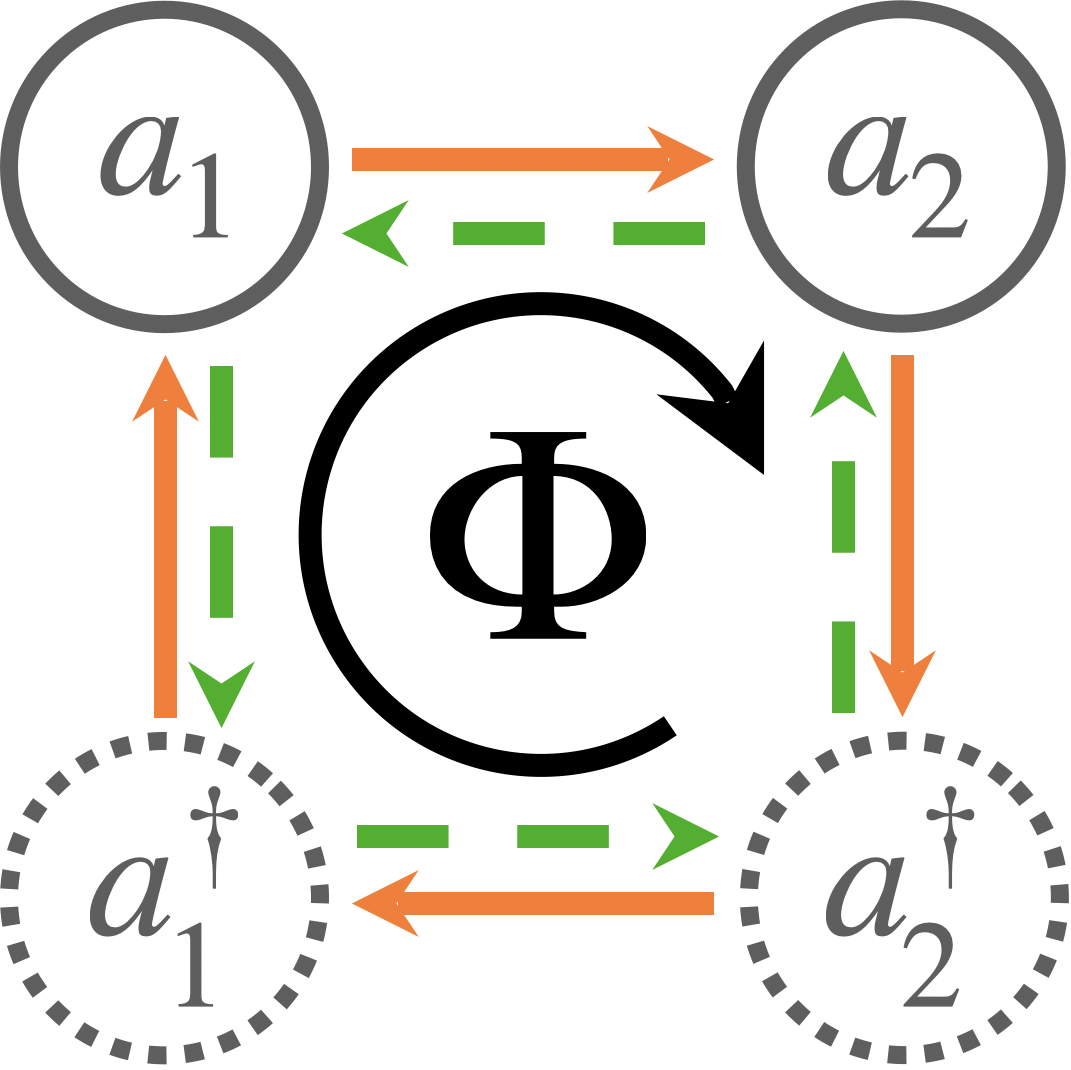 Non-Hermitian chiral phononics through optomechanically-induced squeezingJavier Pino, Jesse J. Slim, and Ewold VerhagenNature, Oct 2022
Non-Hermitian chiral phononics through optomechanically-induced squeezingJavier Pino, Jesse J. Slim, and Ewold VerhagenNature, Oct 2022Imposing chirality on a physical system engenders unconventional energy flow and responses, such as the Aharonov-Bohm effect and the topological quantum Hall phase for electrons in a symmetry-breaking magnetic field. Recently, great interest has arisen in combining that principle with broken Hermiticity to explore novel topological phases and applications. Here, we report unique phononic states formed when combining the controlled breaking of time-reversal symmetry with non-Hermitian dynamics, both induced through time-modulated radiation pressure forces in small nano-optomechanical networks. We observe chiral energy flow among mechanical resonators in a synthetic dimension and Aharonov-Bohm tuning of their hybridised modes. Introducing particle-non-conserving squeezing interactions, we discover a non-Hermitian Aharonov-Bohm effect in ring-shaped networks in which mechanical quasiparticles experience parametric gain. The resulting nontrivial complex mode spectra indicate flux-tuning of squeezing, exceptional points, instabilities and unidirectional phononic amplification. This rich new phenomenology points the way to the exploration of new non-Hermitian topological bosonic phases and applications in sensing and transport that exploit spatiotemporal symmetry breaking.
@article{DelPino2022, title = {{Non-Hermitian chiral phononics through optomechanically-induced squeezing}}, author = {del Pino, Javier and Slim, Jesse J. and Verhagen, Ewold}, year = {2022}, month = oct, journal = {Nature}, publisher = {Springer US}, volume = {606}, number = {7912}, pages = {82--87}, doi = {10.1038/s41586-022-04609-0}, issn = {14764687}, url = {http://arxiv.org/abs/2110.14710 http://dx.doi.org/10.1038/s41586-022-04609-0}, archiveprefix = {arXiv}, arxivid = {2110.14710}, eprint = {2110.14710}, pmid = {35650359}, } -
 HarmonicBalance.jl: A Julia suite for nonlinear dynamics using harmonic balanceJan Košata^*, Javier Pino^*, Toni Louis Heugel, and 1 more authorSciPost Phys. Codebases, Feb 2022
HarmonicBalance.jl: A Julia suite for nonlinear dynamics using harmonic balanceJan Košata^*, Javier Pino^*, Toni Louis Heugel, and 1 more authorSciPost Phys. Codebases, Feb 2022HarmonicBalance.jl is a publicly available Julia package designed to simplify and solve systems of periodic time-dependent nonlinear ordinary differential equations. Time dependence of the system parameters is treated with the harmonic balance method, which approximates the system’s behaviour as a set of harmonic terms with slowly-varying amplitudes. Under this approximation, the set of all possible steady-state responses follows from the solution of a polynomial system. In HarmonicBalance.jl, we combine harmonic balance with contemporary implementations of symbolic algebra and the homotopy continuation method to numerically determine all steady-state solutions and their associated fluctuation dynamics. For the exploration of involved steady-state topologies, we provide a simple graphical user interface, allowing for arbitrary solution observables and phase diagrams. HarmonicBalance.jl is a free software available at https://github.com/NonlinearOscillations/HarmonicBalance.jl.
@article{10.21468/SciPostPhysCodeb.6, title = {{HarmonicBalance.jl: A Julia suite for nonlinear dynamics using harmonic balance}}, author = {Košata^{*}, Jan and del Pino^{*}, Javier and Heugel, Toni Louis and Zilberberg, Oded}, year = {2022}, month = feb, journal = {SciPost Phys. Codebases}, publisher = {SciPost}, pages = {6}, doi = {10.21468/scipostphyscodeb.6}, url = {https://scipost.org/10.21468/SciPostPhysCodeb.6 http://arxiv.org/abs/2202.00571}, archiveprefix = {arXiv}, arxivid = {2202.00571}, eprint = {2202.00571}, }
2020
-
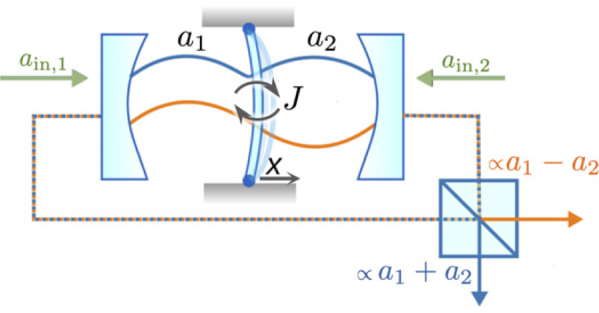 Comparing nonlinear optomechanical coupling in membrane-in-the-middle and single-cavity systemsRoel Burgwal, Javier Pino, and Ewold VerhagenNew J. Phys., Nov 2020
Comparing nonlinear optomechanical coupling in membrane-in-the-middle and single-cavity systemsRoel Burgwal, Javier Pino, and Ewold VerhagenNew J. Phys., Nov 2020In cavity optomechanics, nonlinear interactions between an optical field and a mechanical resonator mode enable a variety of unique effects in classical and quantum measurement and information processing. Here, we describe nonlinear optomechanical coupling in the membrane-in-the-middle (MIM) system in a way that allows direct comparison to the intrinsic optomechanical nonlinearity in a standard, single-cavity optomechanical system. We find that the enhancement of nonlinear optomechanical coupling in the MIM system as predicted by Ludwig et al (2012 Phys. Rev. Lett. 109 063601) is limited to the degree of sideband resolution of the system. Moreover, we show that the selectivity of the MIM system of nonlinear over linear transduction has the same limit as in a single cavity system. These findings put constraints on the experiments in which it is advantageous to use an MIM system. We discuss dynamical backaction effects in this system and find that these effects per cavity photon are exactly as strong as in a single cavity system, while allowing for reduction of the required input power. We propose using the nonlinear enhancement and reduced input power in realistic MIM systems towards parametric squeezing and heralding of phonon pairs, and evaluate the limits to the magnitude of both effects.
@article{Burgwal2020, title = {{Comparing nonlinear optomechanical coupling in membrane-in-the-middle and single-cavity systems}}, author = {Burgwal, Roel and del Pino, Javier and Verhagen, Ewold}, year = {2020}, month = nov, journal = {New J. Phys.}, publisher = {{IOP} Publishing}, volume = {22}, number = {11}, pages = {113006}, doi = {10.1088/1367-2630/abc1c8}, issn = {13672630}, url = {https://iopscience.iop.org/article/10.1088/1367-2630/abc1c8}, keywords = {Dynamical backaction,Membrane-in-the-middle,Multimode optomechanical system,Nonlinear optomechanics,Optomechanics,Quadratic coupling,Quantum measurement} } -
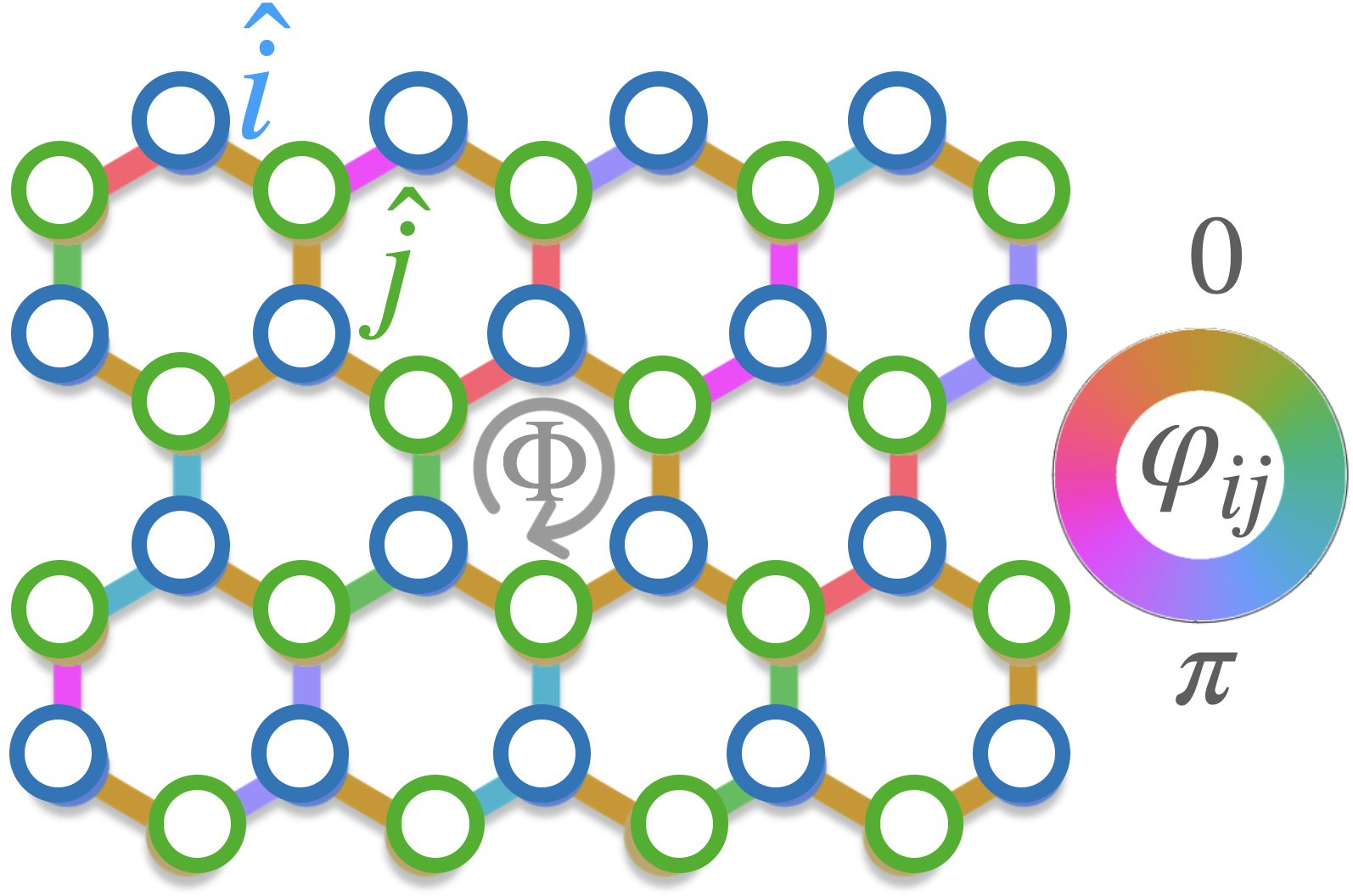 Synthetic gauge fields for phonon transport in a nano-optomechanical systemJohn P. Mathew, Javier Pino, and Ewold VerhagenNat. Nanotechnol., Mar 2020
Synthetic gauge fields for phonon transport in a nano-optomechanical systemJohn P. Mathew, Javier Pino, and Ewold VerhagenNat. Nanotechnol., Mar 2020Gauge fields in condensed matter physics give rise to nonreciprocal and topological transport phenomena and exotic electronic states1. Nanomechanical systems are applied as sensors and in signal processing, and feature strong nonlinearities. Gauge potentials acting on such systems could induce quantum Hall physics for phonons at the nanoscale. Here, we demonstrate a magnetic gauge field for nanomechanical vibrations in a scalable, on-chip optomechanical system. We induce the gauge field through multi-mode optomechanical interactions, which have been proposed as a resource for the necessary breaking of time-reversal symmetry2–4. In a dynamically modulated nanophotonic system, we observe how radiation pressure forces mediate phonon transport between resonators of different frequencies. The resulting controllable interaction, which is characterized by a high rate and nonreciprocal phase, mimics the Aharonov–Bohm effect5. We show that the introduced scheme does not require high-quality cavities, such that it allows exploring topological acoustic phases in many-mode systems resilient to realistic disorder.
@article{mathew2020synthetic, title = {{Synthetic gauge fields for phonon transport in a nano-optomechanical system}}, author = {Mathew, John P. and del Pino, Javier and Verhagen, Ewold}, year = {2020}, month = mar, journal = {Nat. Nanotechnol.}, volume = {15}, number = {3}, pages = {198--202}, doi = {10.1038/s41565-019-0630-8}, issn = {17483395}, url = {http://arxiv.org/abs/1812.09369 https://www.nature.com/articles/s41565-019-0630-8}, archiveprefix = {arXiv}, arxivid = {1812.09369}, eprint = {1812.09369}, pmid = {32015506}, } -
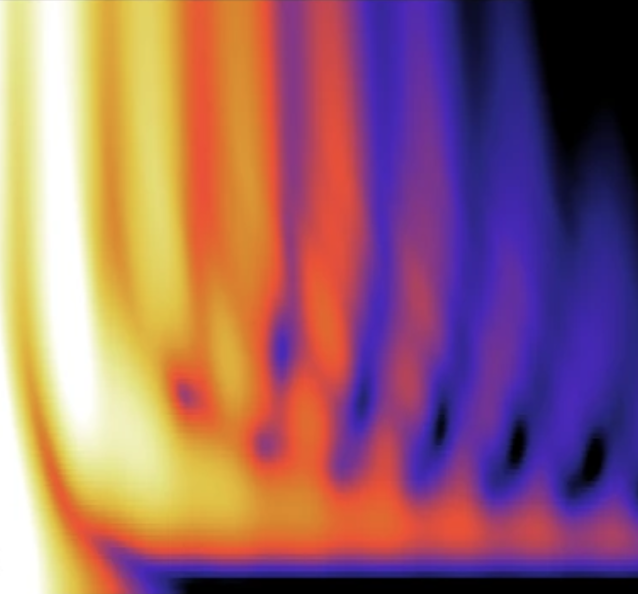 Polaritonic molecular clock for all-optical ultrafast imaging of wavepacket dynamics without probe pulsesR. E.F. Silva, Javier Pino, Francisco J. García-Vidal, and 1 more authorNat. Commun., Mar 2020
Polaritonic molecular clock for all-optical ultrafast imaging of wavepacket dynamics without probe pulsesR. E.F. Silva, Javier Pino, Francisco J. García-Vidal, and 1 more authorNat. Commun., Mar 2020Conventional approaches to probing ultrafast molecular dynamics rely on the use of synchronized laser pulses with a well-defined time delay. Typically, a pump pulse excites a molecular wavepacket. A subsequent probe pulse can then dissociate or ionize the molecule, and measurement of the molecular fragments provides information about where the wavepacket was for each time delay. Here, we propose to exploit the ultrafast nuclear-position-dependent emission obtained due to large light–matter coupling in plasmonic nanocavities to image wavepacket dynamics using only a single pump pulse. We show that the time-resolved emission from the cavity provides information about when the wavepacket passes a given region in nuclear configuration space. This approach can image both cavity-modified dynamics on polaritonic (hybrid light–matter) potentials in the strong light–matter coupling regime and bare-molecule dynamics in the intermediate coupling regime of large Purcell enhancements, and provides a route towards ultrafast molecular spectroscopy with plasmonic nanocavities.
@article{Silva2020, title = {{Polaritonic molecular clock for all-optical ultrafast imaging of wavepacket dynamics without probe pulses}}, author = {Silva, R. E.F. and del Pino, Javier and Garc{\'{i}}a-Vidal, Francisco J. and Feist, Johannes}, year = {2020}, month = mar, journal = {Nat. Commun.}, publisher = {Springer US}, volume = {11}, number = {1}, pages = {1--8}, doi = {10.1038/s41467-020-15196-x}, issn = {20411723}, url = {http://dx.doi.org/10.1038/s41467-020-15196-x}, archiveprefix = {arXiv}, arxivid = {1907.12607}, eprint = {1907.12607}, pmid = {32184408} }
2019
-
 Optomechanically Induced Birefringence and Optomechanically Induced Faraday EffectRobert Duggan, Javier Del Pino, Ewold Verhagen, and 1 more authorPhys. Rev. Lett., Mar 2019
Optomechanically Induced Birefringence and Optomechanically Induced Faraday EffectRobert Duggan, Javier Del Pino, Ewold Verhagen, and 1 more authorPhys. Rev. Lett., Mar 2019We demonstrate an optomechanical platform where optical mode conversion mediated by mechanical motion enables the arbitrary tailoring of polarization states of propagating light fields. Optomechanical interactions are realized in a Fabry-Pérot resonator, which naturally supports two polarization-degenerate states while an optical control field induces rotational symmetry breaking. Applying such principles, the entire Poincaré sphere is spanned by just optical control of the driving field, realizing reciprocal and nonreciprocal optomechanically induced birefringence for linearly polarized and circularly polarized control driving. A straightforward extension of this setup also enables all-optical tunable isolation and circulation. Our findings open new avenues to exploit optomechanics for the arbitrary manipulation of light polarization.
@article{Duggan2019a, title = {{Optomechanically Induced Birefringence and Optomechanically Induced Faraday Effect}}, author = {Duggan, Robert and {Del Pino}, Javier and Verhagen, Ewold and Al{\`{u}}, Andrea}, year = {2019}, journal = {Phys. Rev. Lett.}, publisher = {American Physical Society}, volume = {123}, number = {2}, pages = {23602}, doi = {10.1103/PhysRevLett.123.023602}, issn = {10797114}, url = {https://doi.org/10.1103/PhysRevLett.123.023602}, keywords = {doi:10.1103/PhysRevLett.123.023602 url:https://doi}, pmid = {31386529} }
2018
-
 Tensor Network Simulation of Non-Markovian Dynamics in Organic PolaritonsJavier Del Pino, Florian A.Y.N. Schröder, Alex W. Chin, and 2 more authorsPhys. Rev. Lett., Nov 2018
Tensor Network Simulation of Non-Markovian Dynamics in Organic PolaritonsJavier Del Pino, Florian A.Y.N. Schröder, Alex W. Chin, and 2 more authorsPhys. Rev. Lett., Nov 2018We calculate the exact many-body time dynamics of polaritonic states supported by an optical cavity filled with organic molecules. Optical, vibrational, and radiative processes are treated on an equal footing employing the time-dependent variational matrix product states algorithm. We demonstrate signatures of non-Markovian vibronic dynamics and its fingerprints in the far-field photon emission spectrum at arbitrary light-matter interaction scales, ranging from the weak to the strong coupling regimes. We analyze both the single- and many-molecule cases, showing the crucial role played by the collective motion of molecular nuclei and dark states in determining the polariton dynamics and the subsequent photon emission.
@article{DelPino2018a, title = {{Tensor Network Simulation of Non-Markovian Dynamics in Organic Polaritons}}, author = {{Del Pino}, Javier and Schr{\"{o}}der, Florian A.Y.N. and Chin, Alex W. and Feist, Johannes and Garcia-Vidal, Francisco J.}, year = {2018}, month = nov, journal = {Phys. Rev. Lett.}, volume = {121}, number = {22}, doi = {10.1103/PhysRevLett.121.227401}, issn = {10797114}, archiveprefix = {arXiv}, arxivid = {1804.04511}, eprint = {1804.04511}, pmid = {30547635}, } - PRBTensor network simulation of polaron-polaritons in organic microcavitiesJavier Del Pino, Florian A.Y.N. Schröder, Alex W. Chin, and 2 more authorsPhys. Rev. B, Oct 2018
In the regime of strong coupling between molecular excitons and confined optical modes, the intramolecular degrees of freedom are profoundly affected, leading to a reduced vibrational dressing of polaritons compared to bare electronically excited states. However, existing models only describe a single vibrational mode in each molecule, while actual molecules possess a large number of vibrational degrees of freedom and additionally interact with a continuous bath of phononic modes in the host medium in typical experiments. In this work, we investigate a small ensemble of molecules with an arbitrary number of vibrational degrees of freedom under strong coupling to a microcavity mode. We demonstrate that reduced vibrational dressing is still present in this case, and show that the influence of the phononic environment on most electronic and photonic observables in the lowest excited state can be predicted from just two collective parameters of the vibrational modes. Besides, we explore vibrational features that can be addressed exclusively by our extended model and could be experimentally tested. Our findings indicate that vibronic coupling is more efficiently suppressed for environments characterized by low-frequency (sub-Ohmic) modes.
@article{DelPino2018, title = {{Tensor network simulation of polaron-polaritons in organic microcavities}}, author = {{Del Pino}, Javier and Schr{\"{o}}der, Florian A.Y.N. and Chin, Alex W. and Feist, Johannes and Garcia-Vidal, Francisco J.}, year = {2018}, month = oct, journal = {Phys. Rev. B}, volume = {98}, number = {16}, pages = {165416}, doi = {10.1103/PhysRevB.98.165416}, issn = {24699969}, url = {https://link.aps.org/doi/10.1103/PhysRevB.98.165416}, archiveprefix = {arXiv}, arxivid = {1807.00586}, eprint = {1807.00586} }
2016
- PRLExploiting Vibrational Strong Coupling to Make an Optical Parametric Oscillator Out of a Raman LaserJavier Pino, Francisco J. Garcia-Vidal, and Johannes FeistPhys. Rev. Lett., Dec 2016
When the collective coupling of the rovibrational states in organic molecules and confined electromagnetic modes is sufficiently strong, the system enters into vibrational strong coupling, leading to the formation of hybrid light-matter quasiparticles. In this Letter, we demonstrate theoretically how this hybridization in combination with stimulated Raman scattering can be utilized to widen the capabilities of Raman laser devices. We explore the conditions under which the lasing threshold can be diminished and the system can be transformed into an optical parametric oscillator. Finally, we show how the dramatic reduction of the many final molecular states into two collective excitations can be used to create an all-optical switch with output in the midinfrared.
@article{DelPino2016, title = {{Exploiting Vibrational Strong Coupling to Make an Optical Parametric Oscillator Out of a Raman Laser}}, author = {del Pino, Javier and Garcia-Vidal, Francisco J. and Feist, Johannes}, year = {2016}, month = dec, journal = {Phys. Rev. Lett.}, volume = {117}, number = {27}, pages = {277401}, doi = {10.1103/PhysRevLett.117.277401}, issn = {0031-9007}, url = {https://link.aps.org/doi/10.1103/PhysRevLett.117.277401}, }
2015
- jpccSignatures of Vibrational Strong Coupling in Raman ScatteringJavier Del Pino, Johannes Feist, and F. J. Garcia-VidalJ. Phys. Chem. C, Nov 2015
We have analyzed theoretically how the emergence of collective strong coupling between vibrational excitations and confined cavity modes affects Raman scattering processes. This work was motivated by recent experiments (Shalabney et al. Angew. Chem., Int. Ed. 2015, 54, 7971) that reported enhancements of up to 3 orders of magnitude in the Raman signal. By using different models within linear response theory, we show that the total Raman cross section is maintained constant when the system evolves from the weak-coupling limit to the strong-coupling regime. A redistribution of the Raman signal among the two polaritons is the main fingerprint of vibrational strong coupling in the Raman spectrum.
@article{DelPino2015, title = {{Signatures of Vibrational Strong Coupling in Raman Scattering}}, author = {{Del Pino}, Javier and Feist, Johannes and Garcia-Vidal, F. J.}, year = {2015}, month = nov, journal = {J. Phys. Chem. C}, volume = {119}, number = {52}, pages = {29132--29137}, doi = {10.1021/acs.jpcc.5b11654}, issn = {19327455}, url = {http://arxiv.org/abs/1511.02115 http://dx.doi.org/10.1021/acs.jpcc.5b11654}, } -
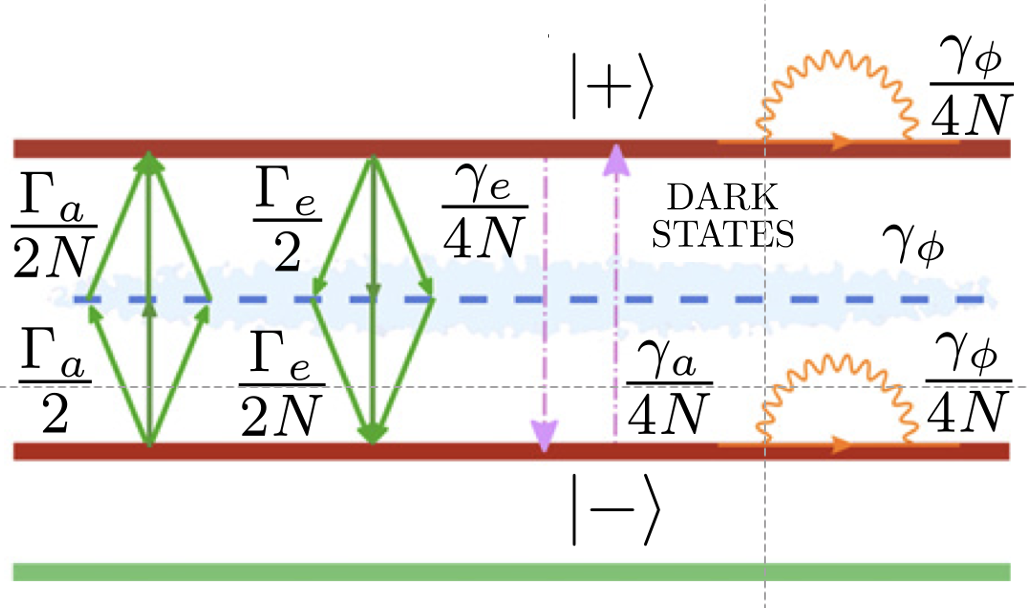 Quantum theory of collective strong coupling of molecular vibrations with a microcavity modeJavier Pino, Johannes Feist, and Francisco J Garcia-VidalNew Journal of Physics, May 2015
Quantum theory of collective strong coupling of molecular vibrations with a microcavity modeJavier Pino, Johannes Feist, and Francisco J Garcia-VidalNew Journal of Physics, May 2015We develop a quantum mechanical formalism to treat the strong coupling between an electromagnetic mode and a vibrational excitation of an ensemble of organic molecules. By employing a Bloch-Redfield-Wangsness approach, we show that the influence of dephasing-type interactions, i.e., elastic collisions with a background bath of phonons, critically depends on the nature of the bath modes. In particular, for long-range phonons corresponding to a common bath, the dynamics of the ’bright state’ (the collective superposition of molecular vibrations coupling to the cavity mode) is effectively decoupled from other system eigenStates. For the case of independent baths (or short-range phonons), incoherent energy transfer occurs between the bright state and the uncoupled dark States. However, these processes are suppressed when the Rabi splitting is larger than the frequency range of the bath modes, as achieved in a recent experiment (Shalabney et al 2015 Nat. Commun. 6 5981). In both cases, the dynamics can thus be described through a single collective oscillator coupled to a photonic mode, making this system an ideal candidate to explore cavity optomechanics at room temperature.
@article{del2015quantum, title = {Quantum theory of collective strong coupling of molecular vibrations with a microcavity mode}, author = {del Pino, Javier and Feist, Johannes and Garcia-Vidal, Francisco J}, year = {2015}, month = may, journal = {New Journal of Physics}, publisher = {IOP Publishing}, volume = {17}, number = {5}, pages = {053040}, }
2014
-
 Entanglement detection in coupled particle plasmonsJavier Pino, Johannes Feist, Francisco J Garcı́a-Vidal, and 1 more authorPhysical Review Letters, May 2014
Entanglement detection in coupled particle plasmonsJavier Pino, Johannes Feist, Francisco J Garcı́a-Vidal, and 1 more authorPhysical Review Letters, May 2014When in close contact, plasmonic resonances interact and become strongly correlated. In this work we develop a quantum mechanical model for an array of coupled particle plasmons. This model predicts that when the coupling strength between plasmons approaches or surpasses the local dissipation, a sizable amount of entanglement is stored in the collective modes of the array. We also prove that entanglement manifests itself in far-field images of the plasmonic modes, through the statistics of the quadratures of the field, in what constitutes a novel family of entanglement witnesses. Finally, we estimate the amount of entanglement, the coupling strength and the correlation properties for a system that consists of two or more coupled nanospheres of silver, showing evidence that our predictions could be tested using present-day state-of-the-art technology.
@article{del2014entanglement, title = {Entanglement detection in coupled particle plasmons}, author = {del Pino, Javier and Feist, Johannes and Garc{\'\i}a-Vidal, Francisco J and Garc{\'\i}a-Ripoll, Juan Jose}, year = {2014}, journal = {Physical Review Letters}, publisher = {APS}, volume = {112}, number = {21}, pages = {216805}, }